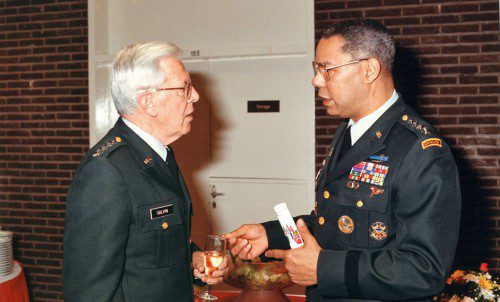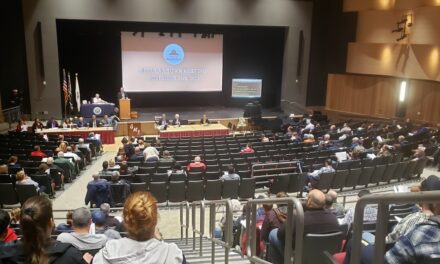
AMONG THE HIGHEST ranking military leaders of the early 1990s, four star U.S. Army Generals John Galvin (left) and Colin Powell discuss world affairs. (Photo courtesy of Mark Curley)
This is the second of two parts.
WAKEFIELD — John Rogers Galvin, mason’s son and retired four star U.S. Army General, will have the new middle school rededicated in his honor Saturday, Nov. 15. As the ceremony approaches, we reflect on his accomplished career as a soldier, statesman and scholar and on some of the important visits he made back to his hometown over the years.
—————
General John R. Galvin succeeded General Bernard Rogers as the military leader of NATO in June 1987. Also that year, he was named “Person of the Year” by the national Association of the United States Army. General Galvin, as Supreme Allied Commander Europe, was charged with the security of Western Europe. He and his wife moved to Brussels, Belgium.
In his NATO post, the general saw the Berlin Wall fall and also had to deal with rising ethnic tensions in Yugoslavia and in the Persian Gulf. The general’s cousin, Town Clerk Mary K. Galvin, and others visited while he was serving as SACEUR and were amazed at how the trappings of his office never seemed to change the man they had known all their lives.
During a WCAT program taping in July 1991 with area reporters, the general had to excuse himself to call then Chairman of the Joint Chiefs of Staff Colin Powell about the situation in eastern Europe. In that interview, conducted to coincide with Galvin being named grand marshal of the reformed Wakefield Independence Day parade, he remained as humble as ever.
The general said values he learned growing up in Wakefield helped him move up through the various ranks of the military.
“When rank is added you have to broaden your horizons and be more capable. You just can’t stand and bark orders. … The basis of my success is the ability to articulate. Teachers like Bernice Caswell (Wakefield High English instructor) gave that to me. I felt special after going through her classes,” he said.
Communicating with the White House, communicating with world leaders and communicating with NATO allies was all part of his day’s work. He said, “Communication is my toughest challenge, seeking the consensus and finding out what other people think.”
Earlier in 1991, during the first Persian Gulf War, the general oversaw the U.S. Command that kept the troops, tankers, planes and parts ready at a moment’s notice to move through Europe and Mediterranean.
In Iraq, hundreds of ethnic Kurds were dying each day as they were being more and more isolated by the late leader Saddam Hussein. Then the 10th Special Forces under Galvin’s command arrived to help with relief efforts. The tide of starvation and illness soon stemmed. The Special Forces and their medical personnel were seen by Kurdish leaders as “angels” saving lives.
In the 1991 Fourth of July parade, which the general led, were troops he commanded in the effort to aid the Kurdish refugees.
The ultimate soldier-statesman, Jack Galvin had the good fortune of seeing the Cold War end on his watch. But the developments in Europe moved so fast that even the head of NATO forces was stunned. He admitted that he could not have predicted some of the sweeping events that changed the makeup of the Eastern Bloc countries and their military forces, nor those that affected the old Soviet Union, either.
“I never expected to walk through Red Square in Moscow unless I went there as a prisoner of war. It’s tremendous, this change that we’ve seen. The changes are good for them, good for the U.S. and good for the world.”
The general was back in Wakefield in the fall of 1991 for ceremonies dedicating the then-Wakefield Junior High School in his name. In a message to students prior to the public event, Galvin’s love of history shone through, a passion he shared with his father.
“You are living in a town which is an example of American history from the time it was Lynn Village to when it became the Town of Wakefield. … As you get ready to go out in the world, the Cold War is over and the United States is the reigning super power, serving as an example of freedom, enterprise and respect for human rights.
“It’s a heavy responsibility to inherit and pick up where those before you have left off,” he said.
That day was a special one for the general, as he had a chance to talk with old friends. It was special for a couple of other reasons, too.
“History is being made here today,” said Atty. Mark Curley, the master of ceremonies and Galvin Committee member. Curley announced the establishment of the Galvin Scholars Program at the school as well as a John Rogers Galvin Scholarship through the former Wakefield Citizens’ Scholarship Foundation.
“The four stars now on the front of this building are emblems of excellence and great personal achievement. Your emblems of excellence will be through the Galvin Scholars Program,” Curley told students that day. “(General Galvin) has climbed his mountain; now you can climb your mountain.”
General Galvin stepped down as NATO commander in 1992, retiring after a 43-year military career. Then-Secretary of Defense Richard Cheney pinned the Distinguished Service Medal, First Order with oak leaf cluster, on Galvin’s uniform during the ceremony in the summer of 1992.
After his military career had ended, the lifelong student and teacher taught at West Point, Ohio State University and served as an envoy with the rank of ambassador to assist in negotiating an end to the crisis in Bosnia, part of the old Yugoslavia.
In 1995, he became the sixth dean of the Fletcher School of Law and Diplomacy at Tufts University. In his reaction to the appointment, Galvin said, “I’ve always felt that the Fletcher mission is a vitally important one. That mission will grow because the world has become more inter-connected. But at the same time, the world is also more complex, more unpredictable – and so many places are potentially unstable.”
There are not enough people who are trained to articulate on the myriad questions and issues that will arise in this unpredictable geopolitical environment, he said. That is the role Galvin wanted to position the Fletcher School to fill.
Wakefield served as an important teaching tool to the general as well. As early as 1993, thanks to the General Galvin Committee made up mostly of local residents, the town hosted high-ranking Russian military leaders several times. Just a few years removed from being sworn enemies, together with their hosts, they had the chance to see small town American life first-hand, visiting places like Smith’s Drug, Hart’s Hardware, the Town Hall, the public safety buildings, the Hartshorne House, First Parish Congregational Church and the old Colonial complex. The events began, of course, with a standard American breakfast at the school named in Galvin’s honored. The elite Russian generals were give black Stetson cowboy hats and jeans which they adored and wore with great pride during their tours of Wakefield.
The general always served. He was on a Congressional commission, for example, that essentially suggested an agency similar to the Department of Homeland Security, two years before the department was created.
In 2002, the general returned to Wakefield once again as guest lecturer of the first lecture sponsored by the Volpe Archives Committee. Not long after the attacks of Sept. 11, 2001, Galvin told those in the audience of the prospect of all-out war, “I hope to God we don’t have to do this at all. If we can get through this period using military and diplomatic power together, then we’ll have it right. … You have to go back and forth (between diplomatic and military efforts). I know that will be difficult to do after two massive buildings were destroyed in New York City.
“We have a chance to take the question of war on again but we have to use everything in our power to stay out of it without deaths and destruction. I think we can make it but we have to be firm. It may be necessary to use force at some point.”
After leading the Fletcher School for five years, General Galvin and his wife retired to a town outside Atlanta, Ga. in 2000.
The rededication of the sparkling new Galvin Middle School Saturday in General Galvin’s honor will include plenty of words about the man who had Wakefield always in his heart and mind.




